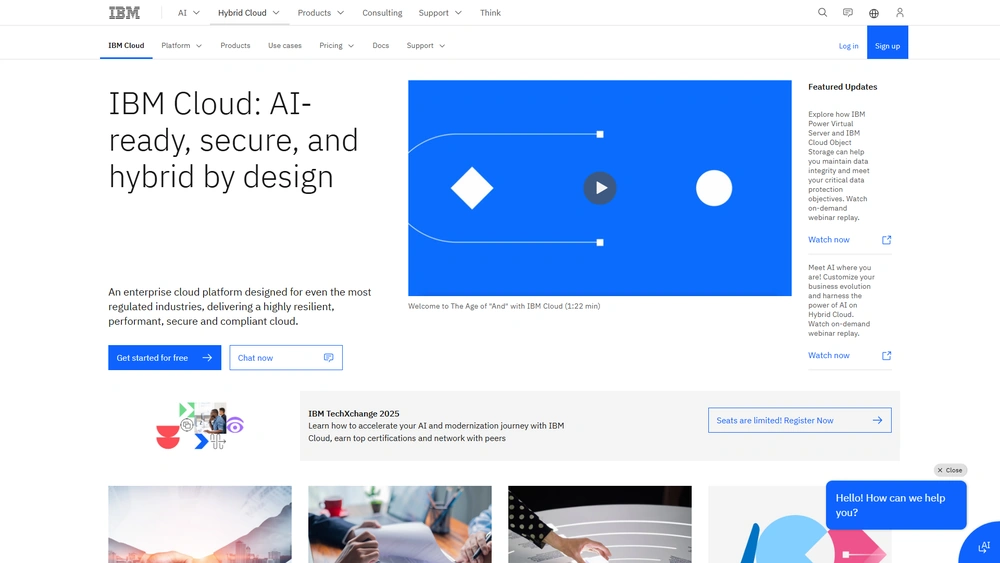IBM Cloud Overview & 2025 Industry Position
As businesses move into a cloud-native, AI-driven landscape, IBM Cloud platform emerges as a top choice for enterprises seeking secure hybrid capabilities, industry-specific solutions, and cutting-edge AI integration. In 2025, IBM Cloud positions itself uniquely among hyperscalers by emphasizing interoperability, compliance-ready infrastructure, and operational control — especially within financial services, healthcare, government, and regulated industries.
From Launch to 2025: IBM Cloud’s Journey
IBM Cloud traces its roots to 2007, initially launched as IBM SmartCloud. IBM dramatically pivoted in 2013 with the acquisition of SoftLayer, combining IaaS capabilities with IBM’s vast enterprise experience. Key milestones include:
- 2013: Acquired SoftLayer and launched IBM Cloud platform.
- 2017: Launched IBM Cloud Private for hybrid deployments.
- 2020: Red Hat OpenShift integration becomes core to IBM Cloud services, reinforcing Kubernetes and container-native architectures.
- 2021: IBM Cloud Satellite introduced — enabling services anywhere via hybrid and multicloud extensions.
- 2024: FinOps and sustainability dashboards added; Watsonx AI models integrated into IBM Cloud workflows.
IBM’s 2025 strategy is centered on providing AI-optimized, secure, and open hybrid cloud infrastructure tailored to regulated industries.

Key Features of IBM Cloud
IBM Cloud stands out in 2025 with robust, secure infrastructure, open integration, and enterprise-grade AI automation. Here are the standout offerings:
- Watsonx AI: Pre-trained, trusted AI models integrated across services for automated operations, insights, compliance alerts, and code generation for apps and workflows.
- Cloud Satellite: Extend IBM Cloud services to any environment (on-prem, edge, or other clouds) with full control.
- Industry-specific Clouds: Configurations dedicated to financial services, telcos, healthcare, and government with built-in compliance support.
- Red Hat OpenShift on IBM Cloud: Fully-managed Kubernetes with pre-integrated CI/CD pipelines, multi-zone resilience, and IAM support.
- Data & Security Services: Confidential computing, integrated Key Protect HSMs, DLP tools, and threat monitoring via IBM Security QRadar SIEM.
Workflow & UX
IBM Cloud has invested in UI uniformity and workflow efficiency. With refreshed dashboards and modular service tiles, navigating services is intuitive. Developers are offered CLI, Terraform, and API automation, while enterprise teams benefit from consumption-based billing visualization and role-based IAM. The console also hosts embedded Watsonx Copilot support for generating deployment scripts, queries, and automation steps based on plain prompts.
IBM Cloud Pricing Analysis & Value Metrics
As of July 2025, IBM Cloud uses a hybrid pricing model combining usage-based compute/network/storage rates with predictable pricing for managed services.
| Plan | Base Price | Includes |
|---|---|---|
| Pay-as-you-go | $0/month | Per-hour billing for IaaS, PaaS, and Watsonx; full dashboard access |
| Startup | $499/month | Dedicated compute, OpenShift cluster, 1TB storage, and tier-1 support |
| Enterprise+ | $3,200/month | 5TB object storage, 3-node OpenShift, Global Load Balancer, Threat Monitoring, App Connect Pro |
Value Assessment: IBM Cloud’s pricing aligns with enterprise-grade dependability, with pay-as-you-go efficiency and tailored enterprise support for regulated markets.
Competitive Landscape
| Platform | Best For | Key Strength | Limitations |
|---|---|---|---|
| IBM Cloud | Regulated industries & hybrid | AI + compliance-grade control | Enterprise focus; learning curve |
| AWS | Developer-first scale | Service breadth, uptime | Complex billing |
| Azure | Microsoft-centric stacks | AD/Teams ecosystem | Opaque documentation |
| Google Cloud | AI/ML intensive workloads | Strong ML APIs | Smaller enterprise share |
Use Cases Across Industries
Popular IBM Cloud scenarios include:
- Financial Services: High-trust transaction processing, data sovereignty, regulatory compliance (e.g., Basel, GDPR).
- Healthcare: HL7/FHIR-ready storage, patient AI agents via Watsonx, secure data lakes.
- Government: FedRAMP-certified workloads, private VLANs, remote Site-hosting.
- Retail/CPG: Supply chain optimization, edge compute for POS/IoT analytics.
Pro Tip: For hybrid compliance deployments, use Cloud Satellite to bring IBM Cloud PaaS to your datacenter or local edge without compromising security posture.
IBM Cloud Integrations
IBM Cloud’s 2025 ecosystem emphasizes open integration for CI/CD, DevOps, observability, and ERP platforms. Highlights:
- Enterprise Apps: Native integrations with Salesforce, SAP, and Oracle Cloud.
- DevOps Suite: Jenkins, GitHub Actions, Tekton support, OpenShift pipelines.
- Observability Tools: Pre-integrated with Datadog, Splunk, Prometheus, Grafana.
- Payments & ERP: IBM Sterling, PayPal, Stripe, and partner banking APIs.
Pros & Cons
- Pro: Enterprise-grade security and AI built-in
- Pro: Industry-tuned cloud environments
- Pro: OpenShift, Satellite, and Red Hat fusion
- Con: Less SMB-friendly UI and pricing tiers
- Con: Complex IAM setup for initial deployments
Final Thoughts
IBM Cloud is best suited for large enterprises, hybrid workloads, and regulated sectors prioritizing control, compliance, and AI-aligned scalability. Teams unfamiliar with IBM’s platform may face a steeper curve, but the reward is unmatched hybrid flexibility, smart observability, and secure AI infrastructure. While not the lowest cost provider, the value in long-term resilience and clarity for mission-critical workloads makes IBM Cloud deployments a viable contender in 2025.
IBM Cloud FAQ
IBM Cloud is recognized for its secure hybrid cloud capabilities, native Red Hat OpenShift integration, and trusted Watsonx AI services tailored to regulated industries.
Yes, via IBM Cloud Satellite, organizations can deploy containers and app services across on-prem, edge, or third-party clouds — all managed centrally.
While IBM Cloud may seem costlier upfront, it often includes value-added services (e.g., integrated AI, compliance frameworks) that reduce total cost of ownership over time.
Yes, Watsonx AI provides pre-trained models, enterprise-focused LLMs, and API-ready intelligence built into IBM Cloud automation and data services.
Absolutely. IBM Cloud’s Startup plan provides OpenShift resources and scalable compute at predictable costs, plus IBM mentorship and startup credits.


